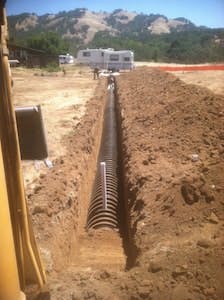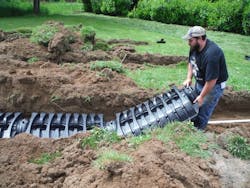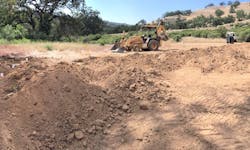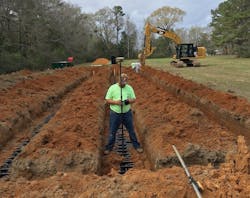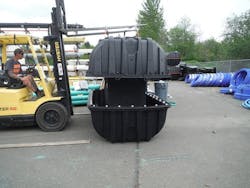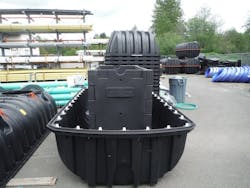Decentralized Wastewater Treatment: Balancing Act
Dennis Hallahan, P.E., is technical director for Infiltrator Water Technologies. Hallahan can be reached at [email protected].
undefinedOne in every three homes in the U.S. is served by an individual onsite septic system. Advances in products, regulations, treatment and disposal strategies have expanded the reach and appeal of the decentralized option from small-flow systems in rural areas to decentralized treatment facilities that serve entire communities. There are decentralized systems that operate at capacities of more than 1 million gal per day.
While treatment needs, design challenges and local regulations vary and dictate what approach is best, whether designing an individual septic system or a large community system, what remains a constant is that decentralized systems provide long-term wastewater treatment performance at an affordable cost.
Decentralized Choice
Where individual onsite septic systems are the norm, town officials have a host of traditional and advanced decentralized treatment system possibilities to protect local waterways and water supplies, upgrade outdated systems to reduce nitrogen loading, and improve overall wastewater management for the community. Communities that choose a sustainable development and wastewater treatment path base the choice on community planning, anticipated growth, economics and environmental sensitivity.
Decentralized wastewater treatment provides treatment and discharge either directly on site or within proximity. The decentralized model collects, treats and discharges to the subsurface all within a local area. This returns the original water resource back to the local aquifer at a much lower energy cost. When adequately designed and installed, decentralized wastewater systems can treat and process large quantities of wastewater into the underlying soils, making this option a passive and sustainable form of aquifer recharge. Rather than partially to fully treating wastewater effluent and then discharging it to a surface pond or injection well before recharging the aquifer, decentralized systems can provide both wastewater treatment and groundwater recharge in one step. Through this sustainable practice, the replenished aquifer then can supply wells, recharge wetlands for wildlife, maintain base flow, and in the case of coastal cities and towns, counteract saltwater intrusion.
Advanced system designs; modular products, such as chambers and geosynthetic aggregate bundles; and lightweight, high-strength plastic septic tanks enable individuals and communities to effectively protect resources and public health. When accessing the best solution for any individual or community wastewater treatment system, a thorough assessment of the challenges; environmental considerations and regulations; design and product options; costs, including operation and maintenance; and future potential expansion needs is key. Homeowner and community education also is critical to long-term solution success.
Communities without public sewer systems or adequate onsite septic systems to employ decentralized strategies can tie into a neighboring centralized wastewater treatment plant with the installation of septic tank effluent pump systems to upgrade individual onsite treatment systems. There are multiple reasons to use an advanced wastewater treatment unit (ATU), including poor soils, shallow vertical separation distances to limiting conditions, horizontal setback restrictions, tight lots, high-strength wastewater, and environmentally sensitive areas.
One type of ATU is a fixed-film bioreactor (FFBR), which is a containment device that houses an engineered PVC media and is used in residential installations, cluster designs and small-to-medium commercial wastewater treatment applications. Often installed inside a plastic tank, they provide higher levels of treatment in areas where traditional systems cannot be installed. These systems shine where nitrogen removal is critical to the treatment plan and are effective for high-strength wastewater applications.
Challenging Conventions
Faced with an aging conventional septic system and the desire to subdivide the property and retain dedicated wastewater treatment service for their existing home, homeowners in Centralia, Wash., needed a new solution. Due to changes in permitting requirements, any new system required the installation of a secondary treatment system to satisfy vertical separation. Several options were rejected due to size requirements, cost and construction challenges. The final design features a FFBR system with pretreatment and a chamber leachfield distribution system to provide seamless collection, treatment and dispersal. All the products utilized in the system design were sourced from the same company.
The effluent discharges from a pretreatment tank and enters the Delta treatment systems ECOPOD-N fixed film wastewater treatment system installed in an Infiltrator IM-1060 plastic reactor tank where it is introduced to an oxygen-rich environment. In this oxygen-rich environment, a colony of bacteria called the biomass develops and digests biodegradable waste into carbon dioxide and water. This process continues as the biomass is supplied with incoming wastewater and oxygen. The effluent then is time-dosed to the 212-ln-ft Infiltrator Quick4 Plus low-profile chamber drainfield with pressure distribution.
In rural locations where a centralized wastewater treatment plant is not available, decentralized treatment is the solution to protect public health. With several options to choose from, most environmental, system sizing, depth to water table or difficult access challenges can be addressed by decentralized treatment.
Rural Obstacles
Live Oak Landing, a rural, riverfront Baldwin County-owned park in Stockton, Ala., is popular with boaters and fishermen, and hosts numerous fishing tournaments each year. Purchased by the county in 2012, the master plan maintains park history, while transforming it into a regional destination. A 2,500-gal-per-day (gpd) wastewater treatment system design was needed to service the proposed new facilities, including a 24-site RV park, public restrooms, an expanded boat ramp, fish cleaning stations, a pavilion, restaurant and cottages.
The large daily flow coupled with site challenges, including a high water table, poor soils and the Tensaw River Watershed location, impacted the ultimate system design. Centralized sewering also was considered by the county; however, a decentralized advanced treatment system ultimately was selected. Due to the environmental sensitivity of the area, pretreatment was required. The system includes a lift station at the RV park to pump the effluent from the RV site to the disposal area, three 4,600-gal concrete tanks, an advanced treatment system and 1,000 ft of Infiltrator Quick 4 Plus low-profile chambers with low-pressure piping.
This was the first truly decentralized wastewater treatment system installed in Baldwin County. The Alabama Onsite Wastewater Assn. utilized the installation as a CEU credit educational opportunity for area installers, many of whom had never seen a large system installation or one incorporating low-pressure piping in chambers after advanced treatment. North Baldwin Utilities participated in the system design and manages the system.
Working With The Water Cycle
Because decentralized wastewater treatment systems return water to the aquifer, thereby replenishing groundwater supplies, they are preferred in remote desert or conservation areas. In these situations, they provide the required treatment and preserve the sensitive environmental balance.
Blue Oak Ranch Reserve is a University of California-owned and operated biological field station and ecological reserve. A proposed renovation of the facilities, including new housing construction and a large utility infrastructure building, required the design of a wastewater treatment system to serve the expansion, protect the surrounding environment and recharge the aquifer.
A wastewater recharge system accommodates the calculated peak usage design flow of 3,280 gpd and includes 231 Infiltrator Quick4 Plus high-capacity chambers in a shallow system installation. Wastewater is dispersed in two separate leachfields. The first leachfield serves the faculty residences and the student cabins, and is a combination of gravity flow and pressurized trenches. The second is a conventional gravity flow system. The two systems have septic tanks as primary treatment with the soils providing final treatment and polishing of the effluent prior to it returning to the local aquifer.
The chambers were installed in trenches with minimal invasiveness and site disruption. The specification of recycled products for the wastewater system resulted in a reduced carbon footprint compared to labor intensive, mined aggregate meeting the Research Station’s sustainability commitment. The decentralized wastewater treatment system design also met the goal of completing the water cycle and replenishing the local aquifer. With funding from the California Wildlife Conservation Board, the project exemplifies full spectrum thinking to achieve water conservation, wastewater treatment and energy sustainability goals.
Finding cost-effective, sustainable solutions for wastewater infrastructure challenges is a balancing act for rural and growing communities. When community leaders and residents define the challenges and future needs, they make the best wastewater treatment choice for that situation. In most cases, the decentralized approach is cost-effective and offers exceptional performance, design and installation versatility, and longevity.

